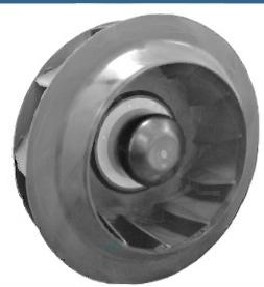What is the working principle of a centrifugal fan

What is the working principle of a centrifugal fan?
When the impeller rotates, the gas between the blades of the centrifugal fan is subjected to centrifugal force to obtain the kinetic energy (dynamic head) discharged from the periphery of the impeller, and the volute guides the flow to the outlet. The heart of the fan is such that the heart of the impeller is located at the heart of the impeller. Negative pressure is formed, so that the external airflow source continuously flows in and supplements, so that the fan can discharge air.
The electric motor transmits power to the fan impeller through the shaft. The rotation of the impeller transfers energy to the air. Under the action of rotation, the air generates centrifugal force. The blades of the fan impeller spread into the surrounding environment. At this time, the larger the fan wheel, the greater the energy received by the air. The larger is, the greater the head (wind pressure) of the fan is. If the large impeller is cut to a small size, the air volume will not be affected, but the air pressure will only be reduced.
Centrifugal fan is mainly composed of impeller and shell. The impeller of the small fan is directly mounted on the motor, and the large fan is connected to the motor through a coupling or pulley. Centrifugal fans generally use single-side air inlets with single-stage impellers; large flow can be double-sided air intake, with two back-to-back impellers, also known as double-suction centrifugal fans.
The impeller is the main component of the ventilator. Its geometry, size, number of blades and manufacturing accuracy have a great influence on performance. The impeller is statically balanced or dynamically balanced to ensure smooth rotation of the fan. According to the direction of the blade outlet, the impeller is divided into three types: forward, radial and backward. The top of the blade of the front impeller is inclined toward the direction of rotation of the impeller; the top of the blade of the radial impeller is radial, divided into straight blades and curved blades; the top of the blade of the rear impeller is inclined to the opposite direction of rotation of the impeller.
Centrifugal fan operation
A centrifugal fan is a mechanical device that uses the force of rotation to create air flow. The fan is usually connected to an electric motor and can be used for a variety of purposes, including ventilation, circulation, and cooling.
Centrifugal fan's operation is simple. A motor spins the blades of the fan, creating a wind flow. This flow is directed by the fan's impeller, which helps to move air around the room.
Centrifugal fans can be operated manually or with an automatic control.
Everything You Need to Know About Centrifugal Fan Operation
Centrifugal fans are an essential piece of equipment in many industries, and have a wide range of applications. They are used to move air or gas in fairly large quantities, and can be used to create positive pressure, negative pressure, or a combination of the two. To get the most out of your centrifugal fan, it is important that you understand how these machines operate.
Reap Maximum Efficiency with Centrifugal Fan Operations
Centrifugal fan operations are an incredibly important part of many industrial processes, as they are able to regulate temperatures and help control dust in the air. Therefore, it is essential to make sure that centrifugal fan operations are running at maximum efficiency. In this article, we will discuss the various ways in which you can ensure that your centrifugal fan operations are working optimally.
Operating a centrifugal fan can be incredibly beneficial for industrial, commercial, and home settings. Centrifugal fans are designed to move air or other gases in one direction, at an increased rate of speed. They are used for cooling and ventilation, as well as controlling humidity levels. By understanding the various components and operations of a centrifugal fan, you can maximize its efficiency for your needs.
The pressure generated by the front impeller is large. When the flow rate and the number of revolutions are constant, the required impeller diameter is small, but the efficiency is usually low. The backward impeller is opposite, the pressure generated, the required impeller diameter is large, and the efficiency is generally higher. The radial impeller is somewhere in between. The profile of the blade is a simple straight blade, and the airfoil blade is complex.
In order to have a suitable velocity distribution on the surface of the blade, a curved blade, such as an arc of the same thickness, is usually used. The impeller usually has a cover disc to increase the strength of the impeller and reduce gas leakage between the blades and the casing. The connection between the blade and the cover is welded or riveted. The welded impeller is light in weight and has a smooth flow path. The impellers of low- and medium-pressure small centrifugal fans are also cast in aluminum alloy.
The above is the "working principle of centrifugal fan", if you have other questions, you can contact us to answer your questions, and you can also learn more about other products. Thank you.Related reading: More centrifugal fans products
-
How to ensure the effectiveness of air suspension centrifugal fans
2020-08-25
-
what is a centrifugal extractor fan
2020-08-17


